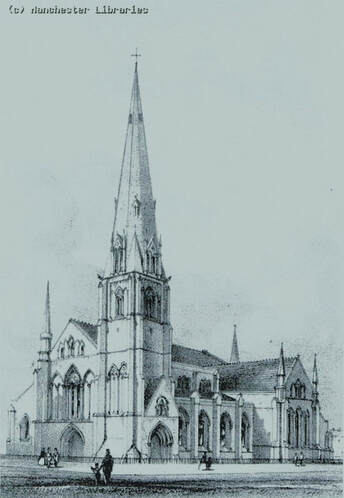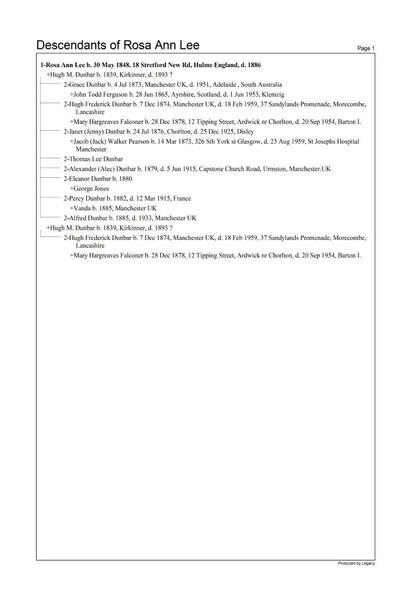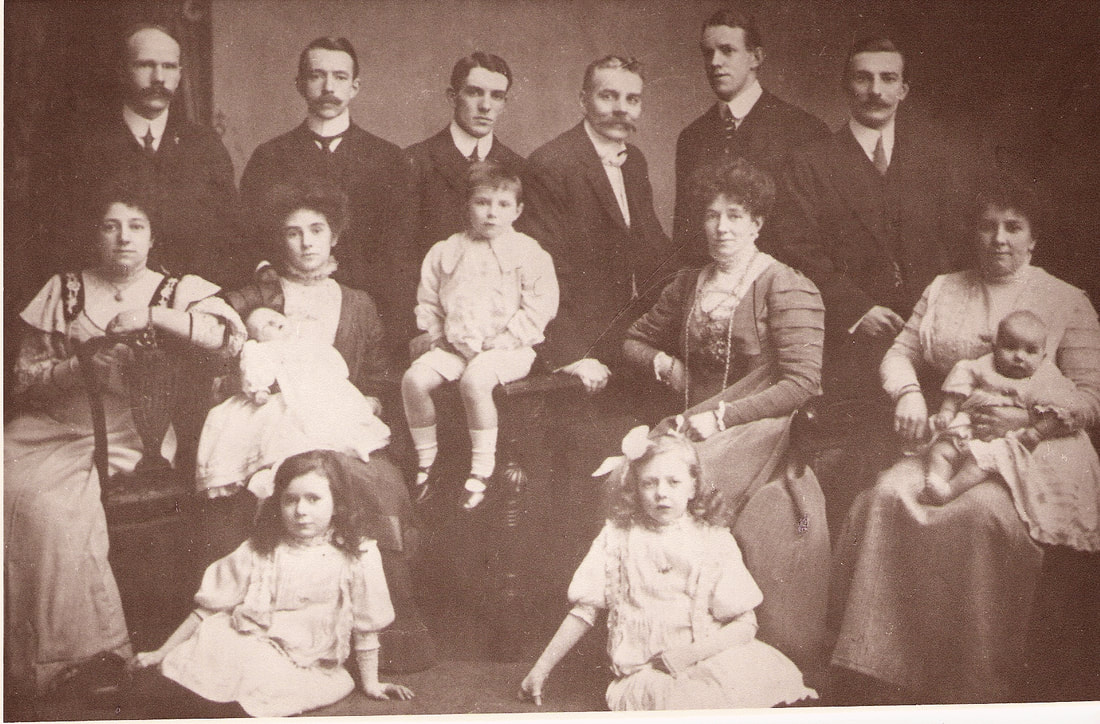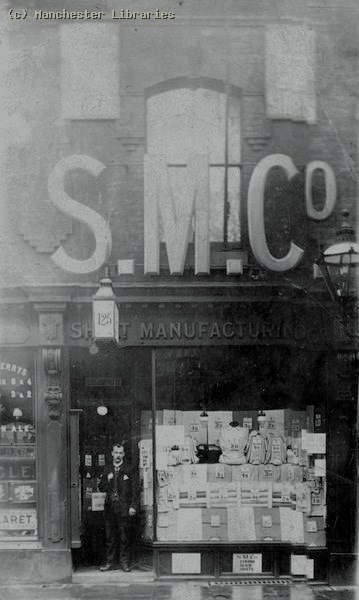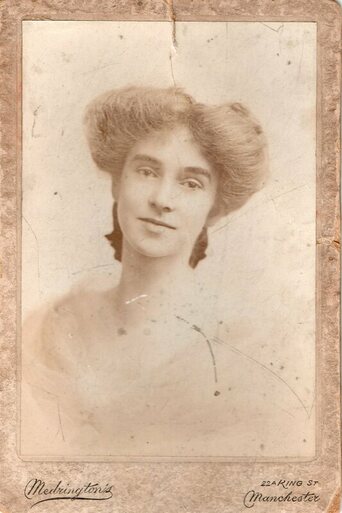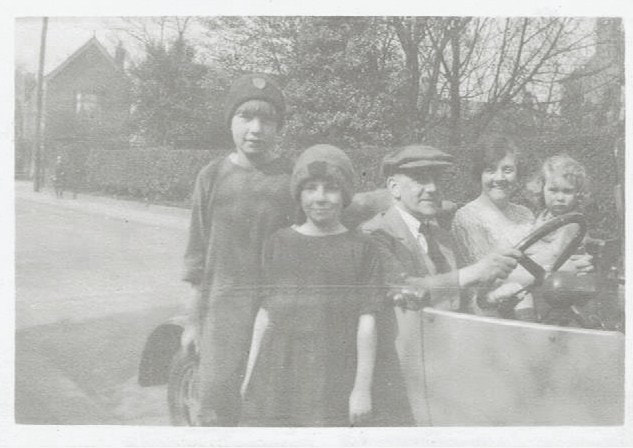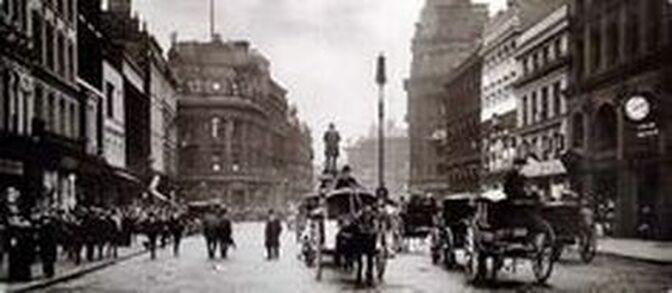DUNBARS IN MANCHESTER
Other significant names: Lee Falconer Crear
Other significant names: Lee Falconer Crear
Hugh M Dunbar (1839- 1893) had moved from Wigtownshire in Scotland to Manchester in Lancashire, England by the time of the 1871 census. Like many other Scots of the time, he became part of the late 1800's mass movement out of rural areas and into the industrial cities. So why Manchester? The railways played a major role in the establishment of the city and the above sketch is from a souvenir book from a book once owned by Thomas Medley Lee , Hugh's father in law, entitled “An Accurate Description of the Liverpool Manchester Railway with and Account of the opening of the Railway.'.."
One commentator said of Manchester
– “its manufacturing district, its vast population, its colossal mills, works and warehouses, its vast extent and variety of manufacturing- its commercial grandeur and magnificence- its scenes of untiring energy and bustle- the workshop of the world.” Cotton of course was the primary resource with Mr Charles Knight a commentator of the time saying ”cotton has brought distant regions of the world into communication; extended the circle of human enterprise and knowledge; it has effaced some of the rust of national prejudice; it has created some towns and increased tenfold the population of others.”
In 1871 Hugh M. Dunbar lived with his sister Janet at 12 Francis Street Chorlton -on- Medlock, an inner suburb of Manchester. He worked as a Travelling Draper – no doubt selling cotton goods to businesses - and Janet worked as a housekeeper. Hugh married Rosa Ann Lee, aged 24, daughter of Thomas Medley Lee and Margaret Crear, on 9 Sep 1872 in Cavendish St Church, Chorlton cum Hardy - suburb of Manchester.
Thomas Lee worked for the Public Bridge Water Works (more about the Lees below) in 1851 and he and Margaret had three other children:
Rosa Ann Lee was born on 30 May 1848 at 18 Stretford New Rd, Manchester. The Lee family later moved to 91 Brook St, Chorlton-on- Medlock and in 1851 to 2 Chester Rd, Hulme - all suburbs of Manchester. By 1871, at the age of 22, Rosa can be found living at 51 Kossuth Tce. Chorlton with her father and siblings, her mother having, presumably, died prior to to this. From this address Rosa worked as a governess and continued as a teacher for most of her life. In her autobiography my grandmother Vera Dunbar (nee Ferguson) wrote
"My grandmother (Rosa Ann Lee) had a small private school which she ran with the help of another lady when each of her seven(sic) children were born" (Autobiography Vera Ferguson , p1)
Hugh M. Dunbar and Rosa lived at 12 Francis Street, Chorlton and in 1875 they moved, with five children and a servant to 73 Grosvenor Street. See Descendant report below for the details of their children ( Hugh is mentioned twice due to IT issue with cousins marrying! Read on !)
Hugh M Dunbar (1839- 1893) had moved from Wigtownshire in Scotland to Manchester in Lancashire, England by the time of the 1871 census. Like many other Scots of the time, he became part of the late 1800's mass movement out of rural areas and into the industrial cities. So why Manchester? The railways played a major role in the establishment of the city and the above sketch is from a souvenir book from a book once owned by Thomas Medley Lee , Hugh's father in law, entitled “An Accurate Description of the Liverpool Manchester Railway with and Account of the opening of the Railway.'.."
One commentator said of Manchester
– “its manufacturing district, its vast population, its colossal mills, works and warehouses, its vast extent and variety of manufacturing- its commercial grandeur and magnificence- its scenes of untiring energy and bustle- the workshop of the world.” Cotton of course was the primary resource with Mr Charles Knight a commentator of the time saying ”cotton has brought distant regions of the world into communication; extended the circle of human enterprise and knowledge; it has effaced some of the rust of national prejudice; it has created some towns and increased tenfold the population of others.”
In 1871 Hugh M. Dunbar lived with his sister Janet at 12 Francis Street Chorlton -on- Medlock, an inner suburb of Manchester. He worked as a Travelling Draper – no doubt selling cotton goods to businesses - and Janet worked as a housekeeper. Hugh married Rosa Ann Lee, aged 24, daughter of Thomas Medley Lee and Margaret Crear, on 9 Sep 1872 in Cavendish St Church, Chorlton cum Hardy - suburb of Manchester.
Thomas Lee worked for the Public Bridge Water Works (more about the Lees below) in 1851 and he and Margaret had three other children:
- Rosa Ann Lee
- Walter J,
- Eleanor
- Margaret
- Percy Crear. (see more about the Creers. )
Rosa Ann Lee was born on 30 May 1848 at 18 Stretford New Rd, Manchester. The Lee family later moved to 91 Brook St, Chorlton-on- Medlock and in 1851 to 2 Chester Rd, Hulme - all suburbs of Manchester. By 1871, at the age of 22, Rosa can be found living at 51 Kossuth Tce. Chorlton with her father and siblings, her mother having, presumably, died prior to to this. From this address Rosa worked as a governess and continued as a teacher for most of her life. In her autobiography my grandmother Vera Dunbar (nee Ferguson) wrote
"My grandmother (Rosa Ann Lee) had a small private school which she ran with the help of another lady when each of her seven(sic) children were born" (Autobiography Vera Ferguson , p1)
Hugh M. Dunbar and Rosa lived at 12 Francis Street, Chorlton and in 1875 they moved, with five children and a servant to 73 Grosvenor Street. See Descendant report below for the details of their children ( Hugh is mentioned twice due to IT issue with cousins marrying! Read on !)
Above Left: 1860 sketch of Cavendish Street Church in Chorlton- cum _ Medlock where Rosa Ann and Hugh Dunbar were married
Above Right: Children of Rosa Ann Lee and Hugh M Dunbar .
Below: Rosa and Hugh Dunbar's children and spouses and grandchildren, .1909 (Hugh Frederik Dunbar and his family missing.)
Above Right: Children of Rosa Ann Lee and Hugh M Dunbar .
Below: Rosa and Hugh Dunbar's children and spouses and grandchildren, .1909 (Hugh Frederik Dunbar and his family missing.)
Hugh M. and Rosa -Ann Dunbar's (nee Lee) children as adults with spouses and children 1909.
Back row: Jack Pearson, Percy Dunbar, Alfred Dunbar, John Ferguson, Alec Dunbar, George Jones
Middle row: Janet Pearson (nee Dunbar), Vanda Dunbar (wife of Percy) holding Ronald, Norman Jones, Grace Ferguson (nee Dunbar) Eleanor Jones (nee Dunbar) holding Marjorie
Front row: Vera Ferguson, Winifred Ferguson.
Missing: Hugh Frederick, Mary (nee Falconer) Rosa and George Dunbar.
Back row: Jack Pearson, Percy Dunbar, Alfred Dunbar, John Ferguson, Alec Dunbar, George Jones
Middle row: Janet Pearson (nee Dunbar), Vanda Dunbar (wife of Percy) holding Ronald, Norman Jones, Grace Ferguson (nee Dunbar) Eleanor Jones (nee Dunbar) holding Marjorie
Front row: Vera Ferguson, Winifred Ferguson.
Missing: Hugh Frederick, Mary (nee Falconer) Rosa and George Dunbar.
|
This wonderful love letter below from Janet Dunbar ( also known as Jennie) to her fiance Jack Pearson gives a delightful glimpse into the lives of the Dunbar family at the time.
30 Hyde Grove My own dear Jack, I was delighted to receive your very interesting letter this morning to know you are so very well Darling. I am very sorry you are not able to come home tomorrow Jack Dear. I have been hoping that you would be, but it is lovely you feel that you really are coming next week. I wish I could feel sure that I could have you for Wednesday night Darling as Alec is going to a dance at Urmston & staying the night at Hugh’s so we could have a long time together. Dear supposing you till 10 0’clock. Well! Darling, I know you will do your best to get back to me & I am looking forward to a delightful time with you. Alec has gone to the dance & I felt quite glad I was not going because I wanted to have a nice chat with you however just as I had got nicely settled down Gracie arrives & I have to talk to her, but she has gone now. By the by, she wants to come to the dance next Saturday & wants me to get her a ticket. I had a letter from Mr Warnock this morning asking me if I wanted tickets for George & Elie but they were here last night & told me they did not intend going this time. Elie is staying home & letting Grace come. I think she is going to pal with Ma McLean. Well Dearie I am quite my old self again & I am very pleased to hear you are so well. Fancy, I have never been so long without seeing you since I first knew you. I have not been out one night since you went away with the exception of Wednesday night at Gracie’s last week. We have had a dreadful storm here last night & this morning & we could not get sleeping through the night for the windows making such an awful, but it is beautifully calm tonight & so clear. I am thinking had you been at Plymouth Grove I would have been coming to take you for a walk Darling. About Sousa Jack! I am going with Percy on Tuesday. I am very sorry I cannot go with you Dear but never mind I am looking forward to the dance next Saturday with you. Gracie wanted to know & I did not know whether there is to be a tea first or not, you might tell me in your next letter then I can let her know. I could not help laughing when I heard you had been playing Ping Pong. I thought what next. I have got hold of a wretched pen & cannot find another so excuse this scrawl. You told me how you have been thinking after you go to bed Darling well I know what that means Dearie as I have lain awake each night thinking of you & of all the nice times we have had together & are going to have If we are spared to each other Darling Jack Dear if you were only here now so that I could be in my usual place, but no use Jack I am saving all my kisses Darling. No more at present but Dearie let me have a nice long letter on Sunday morning & then I can perhaps know about Wednesday. Ever your loving Jennie |
Rosa Ann Dunbar died in 1886 aged 38, just 18 months after Alfred’s birth and, by 1891, her widower Hugh lived with all his 7 children and his sister Janet at 125 Stretford Road, Hulme above the Shirt Shop which he managed for the Shirt Manufacturing Company.
The photo to the left is that shop although it was taken after the Dunbars had left. By 1895 Grace, their eldest daughter,was the Manageress of the shop, aged just 22. It was no doubt during this time that she acquired the skills she used to manage a family owned business; skills she took with her to rural South Australia some years later. Hugh M. Dunbar died about 1893 aged 54 and by 1901 five of the Dunbar siblings were still living together at 30 Hyde Grove, Chorlton upon Medlock. They were all working: Alexander - Engineers Representative, Alfred – Clerk to Towel Manufacturer, Eleanor - Draper’s Assistant, Janet – Draper’s assistant and Percy – Insurance Clerk. Hugh Dunbar with his daughter Rosa Petter and Mary (Rosemary) Petter.
Above: Vanda married Percy Dunbar .
Alfred Dunbar, with nieces Jessie (Janet) Pearson, Eileen Jones, his brother Hugh's wife May Dunbar ( nee Falconer) & her grandchild Mary (Rosemary) Petter.
|
Above: Picadilly Manchester in late 1800s.
Below: Excerpts from Vera Alexandra Ferguson's (Grace Dunbars' daughter) Autobiography re her life in Manchester
My earliest recollections are of living in a 3 storied house at 365 Dickinson Road, Longsight, Manchester, I was 3 ½ when we moved from there but I remember passing around cakes at one of my mother’s tea parties and then being allowed to go out through the French windows to play in a walled-in back garden where a cat often appeared on the wall but I was told it was a Tom cat and not to be trusted, in fact all pets were taboo. My sister & I used to play in the attic and I remember cutting out the black velvet dots on an old veil & then feeling repelled by them because they looked like nasty little beetles. We were sometimes taken to play in a nearby park by a nanny who was dressed in a long skirted grey costume with a flowing cape and snug fitting bonnet – the traditional out-fit for a nanny in those days. I recognised the entrance to the park when I passed there on bus bound for a Manchester bus depot in 1964 while spending a weekend with my cousin Marjorie Paulson. When I was 3 ½ years old we moved to Halesdon Rd, Heaton Chapel, which in those days was an outer suburb of Manchester and almost rural. Our house there was only a two storied one but had a small front garden where pansies flourished and a large back lawn where we would lie on summer days and watch the larks soaring high into the sky. Part of the Manchester Ship Canal flowed not far from our house and I remember going there with my father and sailing the little paper boats that he made for me.
Buttercups and daisies grew in profusion near our house and scarlet poppies growing in the wheat or corn fields have always made a greater impression on my mind than even the most exotic orchids. It must have been when we went to a farm in Hayfield for our summer holidays one year that I remember lying down amongst the heather and there were hills at the back of the farm where we rambled and picked blueberries which were made into pies and eaten with rich farm cream. Sometimes we went to St Anne’s and Blackpool where the smell of the sea was such a delight, the sand so firm and clear when the tide would go away out, and donkey rides were such a thrill. Punch & Judy shows were always an added attraction and Nigger Minstral Shows were on nightly in the Pavilion at the far end of the pier.
(When I was 5 we met the poet Donald McLean on one of our holidays and he wrote a poem for me which is now printed in a book of his poems which is now in Bob’s possession.
I attended the kindergarten class of a private school before I turned four and remember learning to write by first making rows of “pot – hooks,” painting symmetrical flowers with a pointed brush and holding the brush flat with the point away from the centre and plasticine modelling was a favourite pastime. My sister had a box of paints given to her before I did and how I longed for some of my own because she would only let me use the black or dark brown colour and I craved something brighter.
In 1907 my father and mother visited his family in Ayr and attended the Edinburgh Exhibition where they bought the lovely glass goblet engraved with my name and visited Inverary Castle where they got the little china cup and saucer with the castle painted on it. My sister & I were left in the care if the family who ran the private school and felt privileged to be boarders instead of day scholars for a change. All I seem to remember about the boarding period is of a fine looking gentleman standing at the top of the stairs in a large entrance hall and he threw down paper wrapped toffees for the little girls to scramble for. I think the only time I have ever seen a hummingbird was when a man brought one to school one day in a cage and I couldn’t believe that such a tiny little bright coloured creature could really be alive but we were enthralled with its activities. Getting to school on some winter days was a bit of a problem and , when the snow was deep, my father would carry me over the worst places but mostly we enjoyed sliding along the ice in the gutters and throwing snowballs at our friends – I don’t remember any enemies.
My mother’s oldest brother Hugh and his family lived in a big house called “Capstone” in Urmston and the whole clan came there for our last Christmas day in England. We were there a day or two beforehand and while my mother helped Auntie May to make the mince pies and other goodies my sister & I helped Rosa & George to make a snowman on the back lawn. I remember finding 2 round black stones for his eyes and Auntie May gave me a carrot for his nose. When I awoke on Christmas morning I was thrilled to find a lovely strong wooden cradle among my presents but was later told that I would not be able to keep it as we were so soon to start packing up to leave for Australia ( on March 5th 1909).
Below: Excerpts from Vera Alexandra Ferguson's (Grace Dunbars' daughter) Autobiography re her life in Manchester
My earliest recollections are of living in a 3 storied house at 365 Dickinson Road, Longsight, Manchester, I was 3 ½ when we moved from there but I remember passing around cakes at one of my mother’s tea parties and then being allowed to go out through the French windows to play in a walled-in back garden where a cat often appeared on the wall but I was told it was a Tom cat and not to be trusted, in fact all pets were taboo. My sister & I used to play in the attic and I remember cutting out the black velvet dots on an old veil & then feeling repelled by them because they looked like nasty little beetles. We were sometimes taken to play in a nearby park by a nanny who was dressed in a long skirted grey costume with a flowing cape and snug fitting bonnet – the traditional out-fit for a nanny in those days. I recognised the entrance to the park when I passed there on bus bound for a Manchester bus depot in 1964 while spending a weekend with my cousin Marjorie Paulson. When I was 3 ½ years old we moved to Halesdon Rd, Heaton Chapel, which in those days was an outer suburb of Manchester and almost rural. Our house there was only a two storied one but had a small front garden where pansies flourished and a large back lawn where we would lie on summer days and watch the larks soaring high into the sky. Part of the Manchester Ship Canal flowed not far from our house and I remember going there with my father and sailing the little paper boats that he made for me.
Buttercups and daisies grew in profusion near our house and scarlet poppies growing in the wheat or corn fields have always made a greater impression on my mind than even the most exotic orchids. It must have been when we went to a farm in Hayfield for our summer holidays one year that I remember lying down amongst the heather and there were hills at the back of the farm where we rambled and picked blueberries which were made into pies and eaten with rich farm cream. Sometimes we went to St Anne’s and Blackpool where the smell of the sea was such a delight, the sand so firm and clear when the tide would go away out, and donkey rides were such a thrill. Punch & Judy shows were always an added attraction and Nigger Minstral Shows were on nightly in the Pavilion at the far end of the pier.
(When I was 5 we met the poet Donald McLean on one of our holidays and he wrote a poem for me which is now printed in a book of his poems which is now in Bob’s possession.
I attended the kindergarten class of a private school before I turned four and remember learning to write by first making rows of “pot – hooks,” painting symmetrical flowers with a pointed brush and holding the brush flat with the point away from the centre and plasticine modelling was a favourite pastime. My sister had a box of paints given to her before I did and how I longed for some of my own because she would only let me use the black or dark brown colour and I craved something brighter.
In 1907 my father and mother visited his family in Ayr and attended the Edinburgh Exhibition where they bought the lovely glass goblet engraved with my name and visited Inverary Castle where they got the little china cup and saucer with the castle painted on it. My sister & I were left in the care if the family who ran the private school and felt privileged to be boarders instead of day scholars for a change. All I seem to remember about the boarding period is of a fine looking gentleman standing at the top of the stairs in a large entrance hall and he threw down paper wrapped toffees for the little girls to scramble for. I think the only time I have ever seen a hummingbird was when a man brought one to school one day in a cage and I couldn’t believe that such a tiny little bright coloured creature could really be alive but we were enthralled with its activities. Getting to school on some winter days was a bit of a problem and , when the snow was deep, my father would carry me over the worst places but mostly we enjoyed sliding along the ice in the gutters and throwing snowballs at our friends – I don’t remember any enemies.
My mother’s oldest brother Hugh and his family lived in a big house called “Capstone” in Urmston and the whole clan came there for our last Christmas day in England. We were there a day or two beforehand and while my mother helped Auntie May to make the mince pies and other goodies my sister & I helped Rosa & George to make a snowman on the back lawn. I remember finding 2 round black stones for his eyes and Auntie May gave me a carrot for his nose. When I awoke on Christmas morning I was thrilled to find a lovely strong wooden cradle among my presents but was later told that I would not be able to keep it as we were so soon to start packing up to leave for Australia ( on March 5th 1909).
THE LEES
Before moving onto the Grace and Hugh Dunbar, my great grandparent lets back track to the family of their mother Rosa Ann Lee.
The earliest known Lee was Bielby Lee born in 1801. He worked as a Tallow Chandler ( candle maker) in 1818 in Sculcoates, Yorkshire. He married twice, firstly to Mary Medley the daughter of Thomas Medley .
The children from this marriage were all born in Hull and were :
Bielby next married Ann Dale on 26 Sep 1826 in York.
Children from this marriage were:
By 1841 Bielby Lee senior working as an Agent in 1841 in Ardwick, Manchester and resided in Thomas Street, Ardwick, Manchester.
Thomas Medley Lee married Margaret Crear at Braddan on the Isle of Man, Margaret’s home town. (see XXxX) At the time of their daughter’s birth in 1848 they lived at 18 Stretford New Rd, Manchester. In 1851 he worked as a Commercial Clerk with the Public Bridge Water Works and the family lived at and at Chester Rd, Hulme, Manchester. By 1871 Margaret had died and Thomas lived at 51 Kossuth Tce, Chorlton Manchester and worked as a Calico Salesman .
Thomas and Margaret had five children;
“Alfred (Dunbar) was only eighteen months old when..( his) mother (Rosa Ann Lee or Dunbar) died & my mother (Grace) then aged 13 became of mother head of the family and looked after them with the help of an old family retainer by the name Bessie and a well to do Aunt Nell, (Mrs Alfred Morris) who was childless but who had a very benevolent husband (Alfred Morris) who owned a motor-car which was rare in those days.
Now read about three of the Dunbars and their spouses here
GRACE DUNBAR AND JOHN FERGUSON IN MANCHESTER
Hugh F Dunbar
Falconers
THE LEES
Before moving onto the Grace and Hugh Dunbar, my great grandparent lets back track to the family of their mother Rosa Ann Lee.
The earliest known Lee was Bielby Lee born in 1801. He worked as a Tallow Chandler ( candle maker) in 1818 in Sculcoates, Yorkshire. He married twice, firstly to Mary Medley the daughter of Thomas Medley .
The children from this marriage were all born in Hull and were :
- Thomas Medley born on 15 Mar 1818 and was christened on 27 Mar 1818 in Bethel Chapel, North Street Bridge Street,Methodist.
- John Bielby born on 29 Jul 1819 in Kingston- on - Hull and was christened on 31 Aug 1819 and baptised on 31 Aug 1819 in Bethel Chapel, North Street Bridge Street. He worked as a Clerk in 1841 in Ardwick, Manchester.
- Elizabeth Jane born on 15 Jul 1824 .
- William Henry born on 29 Apr 1822
Bielby next married Ann Dale on 26 Sep 1826 in York.
Children from this marriage were:
- Bielby born on 3 Aug 1827
- Ann born in 1831.
- Mary born in 1833.
- Edward born in 1836.
By 1841 Bielby Lee senior working as an Agent in 1841 in Ardwick, Manchester and resided in Thomas Street, Ardwick, Manchester.
Thomas Medley Lee married Margaret Crear at Braddan on the Isle of Man, Margaret’s home town. (see XXxX) At the time of their daughter’s birth in 1848 they lived at 18 Stretford New Rd, Manchester. In 1851 he worked as a Commercial Clerk with the Public Bridge Water Works and the family lived at and at Chester Rd, Hulme, Manchester. By 1871 Margaret had died and Thomas lived at 51 Kossuth Tce, Chorlton Manchester and worked as a Calico Salesman .
Thomas and Margaret had five children;
- Walter Thomas born in 1847. He worked as a Mariner in 1871
- Rosa Ann born on 30 May 1848 in, Hulme. (see more about Rosa Ann in the above Dunbar section.)
- Eleanor Margaret born in 1850 . She married Alfred John Morris 1873 in Chorlton. Alfred was born about 1848 in London, Middlesex and died after 1881.• He worked as an Oil Merchant in 1881 employing 9 men. They lived in 91 Withington Rd, Moss Side, Manchester. The following reference to Eleanor appears in Vera Ferguson’s Autobiography.
“Alfred (Dunbar) was only eighteen months old when..( his) mother (Rosa Ann Lee or Dunbar) died & my mother (Grace) then aged 13 became of mother head of the family and looked after them with the help of an old family retainer by the name Bessie and a well to do Aunt Nell, (Mrs Alfred Morris) who was childless but who had a very benevolent husband (Alfred Morris) who owned a motor-car which was rare in those days.
- Frederick John born in 1853 in Lancashire. He worked as a Manchester Trade apprentice in 1871
- Percy Crear born in 1855 • He worked as a Drapers Apprentice in 1871 in Chorlton.
- Fanny Anne born in 1868
Now read about three of the Dunbars and their spouses here
GRACE DUNBAR AND JOHN FERGUSON IN MANCHESTER
Hugh F Dunbar
Falconers
Proudly powered by Weebly
